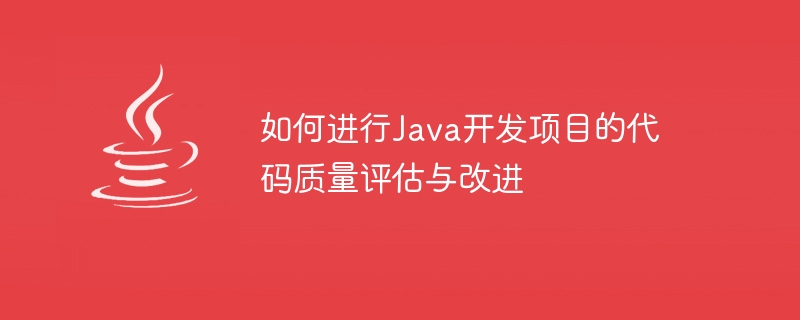Home >Java >javaTutorial >How to evaluate and improve code quality of Java development projects
How to evaluate and improve code quality of Java development projects
- WBOYWBOYWBOYWBOYWBOYWBOYWBOYWBOYWBOYWBOYWBOYWBOYWBOriginal
- 2023-11-03 16:47:001037browse

How to evaluate and improve the code quality of Java development projects
Abstract: With the continuous development of software development, code quality has become an important factor in ensuring the maintainability and maintainability of software systems. One of the important factors of scalability. This article aims to introduce how to evaluate and improve the code quality of Java development projects, explain it from the aspects of code specifications, code complexity, code duplication, unit testing and code review, and put forward corresponding solutions and suggestions.
- Introduction
With the rapid development of the software development industry, Java has become one of the most popular programming languages. However, as projects increase in size and complexity, the assessment and improvement of code quality becomes increasingly important. Good code quality can not only improve the readability and maintainability of the code, but also reduce the code error rate and improve project development efficiency. Therefore, how to evaluate and improve the code quality of Java development projects has become an important issue that every developer should pay attention to. - Code Standards
In Java development projects, good code standards are an important part of ensuring code quality. Through unified naming rules, code structure and comment specifications, the readability and maintainability of the code can be improved, and the communication cost between developers can be reduced. Developers should strictly abide by the code specifications set by the company or team, and use tools (such as Checkstyle and SonarQube) to automatically check code style. - Code complexity
Code complexity is one of the important indicators for evaluating code quality. Excessive code complexity can make code difficult to understand and maintain. Developers can use code analysis tools such as PMD and FindBugs to assess the complexity of code and make improvements accordingly. By extracting public methods, splitting complex logic and reducing the nesting level of methods, the complexity of the code can be effectively reduced. - Code duplication
Code duplication is one of the main causes of reduced code quality and maintainability. A large amount of duplicate code not only consumes developers' time and energy, but also increases the error rate of the code. In order to solve the problem of code duplication, developers can use code refactoring tools (such as Eclipse and IntelliJ IDEA) to refactor code, extract duplicate code into public methods or classes, and use version control tools to compare and merge code differences. - Unit testing
Unit testing is one of the important means to ensure code quality. By writing comprehensive and effective unit tests, problems in the code can be discovered in time and the correctness and stability of the code can be guaranteed. Developers should develop the habit of writing unit tests during the project development process, and use unit testing frameworks (such as JUnit and Mockito) for automated execution of unit tests. - Code Review
Code review is one of the important links to ensure code quality. Through code review, potential problems and irregularities in the code can be discovered, and corresponding improvement suggestions can be given. Developers can conduct code reviews through pair programming, regular code review meetings, or using code review tools such as Crucible and Review Board. - Conclusion
This article introduces how to evaluate and improve the code quality of Java development projects. By adhering to code specifications, reducing code complexity, eliminating code duplication, strengthening unit testing, and conducting code reviews, you can effectively improve code quality and ensure the maintainability and scalability of the project. I hope this article can provide developers with some practical guidance and suggestions to improve the code quality of Java development projects.
The above is the detailed content of How to evaluate and improve code quality of Java development projects. For more information, please follow other related articles on the PHP Chinese website!

